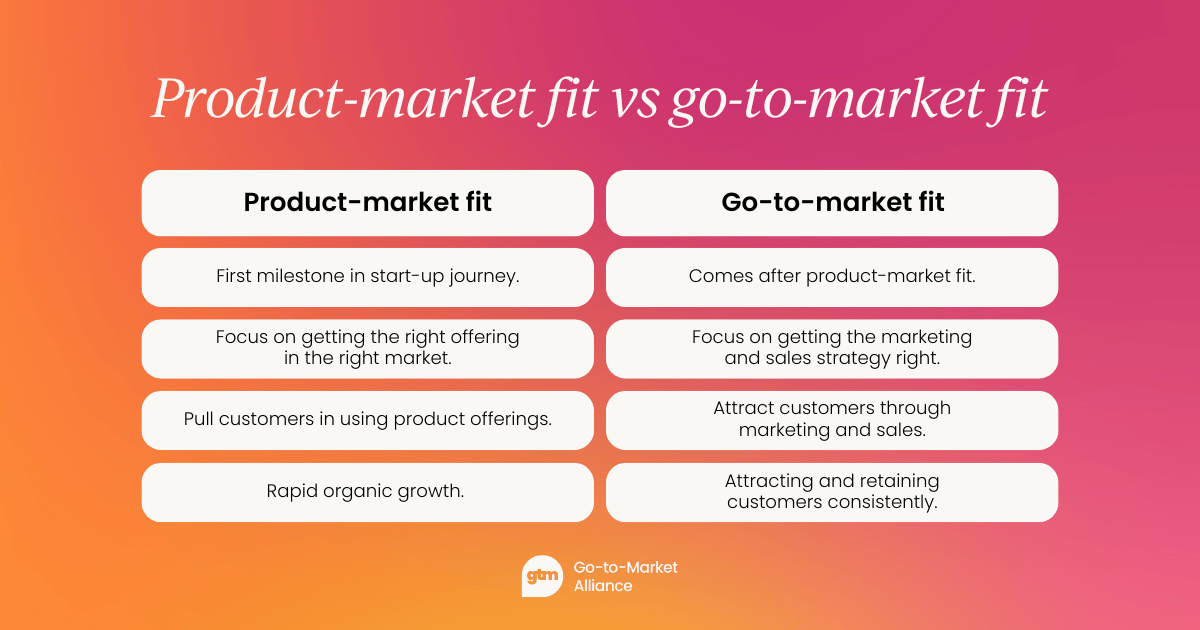When starting your start-up journey, working out your next milestone can be tricky. Should you reach product-market fit or go-to-market fit first?
And what’s the difference between the two?
In case you’re in a rush, product-market fit is where your product fills a gap in the market for your customers, whereas go-to-market fit is selling your product in the right way for your audience.
Ready to learn more about these differences? This article covers:
- What product-market fit is and why it’s important
- What go-to-market fit is and why it’s important
- How to achieve product-market fit
- How to measure product-market fit
- How to achieve go-to-market fit
- How to measure go-to-market fit
What is product-market fit?
Product-market fit means there’s market demand for your product and your offering will satisfy your target customers’ needs better than alternatives.
While product-market fit is a simple concept in theory, in practice, it can be hard to define exactly what it means for your business. Although some go-to-market (GTM) veterans can sometimes “just know” when they’ve achieved product-market fit.
“In the early stages, pre-product-market fit, founders push their product into the market. But then, at some point, the best companies achieve product-market fit, which is characterized by a pull from the market.
“This pull manifests in several ways. Customers start demanding your product. They come to you. They tell their friends about it. Many who have experienced this will tell you it’s a feeling, but there are ways to quantify this pulling force.”
– Egan Montgomery, Co-Founder and VP of Marketing at Backstroke.
Some indicators you may have reached product-market fit include:
- Customers want to buy your product and are pulled toward your solution.
- Customers rave about your offering unprompted, sharing the word with peers, friends, and online.
- Your product fills a gap in the market and solves your target audience’s pain points.
- Your product is generating organic growth without much effort.
Why is achieving product-market fit important?
Without product-market fit, your company can’t grow. It’s really that simple.
Product-market fit allows you to:
- Grow rapidly. Customers will see the value in your offering and flock to purchase from you.
- Low customer acquisition cost. Your product has a pull factor that means your customer will purchase without flashy marketing campaigns.
- Keep customers happy and loyal. The product fills a gap and is the best solution for your target market’s problem. Many say they can’t live without it!
- Gain recognition in the market. The buzz you’ve created can’t be ignored - with so much positive word of mouth, people start taking notice.

What is go-to-market fit?
Go-to-market fit is about ensuring your product is being sold and marketed in the right way for your prospects.
A strong GTM fit ensures you’ll acquire and retain customers consistently and can scale up your organization with ease.
Essentially go-to-market fit is the next step in your company’s journey towards becoming a category leader. This means solidifying your sales strategy, defining your ICP and buyer personas, and improving your product-market fit.
Pricing also plays a role in go-to-market fit. While working towards product-market fit, most pricing will be custom while you nail down your offering. Once you start moving toward GTM fit it’s crucial to formally define your pricing strategy.
This will allow your sales team to get contracts out the door quicker, ramping up your sales cycle, and allowing your sales organization to scale sustainably.
Why is achieving go-to-market fit important?
After achieving product-market fit, many organizations start rapidly ramping up their sales and marketing efforts and spend, without laying down the foundations. AKA skipping GTM fit.
This is a huge mistake as skipping GTM fit will lead to stagnated growth as your sales strategy isn’t up to par. These increases in sales rep headcount, won’t turn into increased revenue without a strong go-to-market fit.
Achieving go-to-market fit will mean your organization is ready to scale up sustainably since the correct frameworks have been laid out.
What’s the difference between product-market fit and go-to-market fit?
In case it isn’t already clear what the difference is between product-market fit and GTM fit, here’s a quick summary.
Product market fit is the first key milestone in your start-up journey as you successfully fill a gap in the market and pull in customers.
Whereas, go-to-market fit is the next stage in your start-up journey when you solidify your sales and marketing strategies. This allows you to sell in the right way and scale effectively.

4 steps for achieving a product-market fit
Now that we’ve cleared up the difference between these terms, how do you achieve product-market fit? We’ve outlined four key steps.
Determine target customer and pain points
The first step on your journey to product-market fit is understanding your potential customers. Because let’s face it, you can’t create a product they’ll love without knowing anything about them.
Utilize market research to discover insight into your target customer and create buyer personas to help you keep your audience in mind when creating your product. These personas should provide your team with detailed information about your ideal customer.
Some questions to consider are:
- What job do they do?
- Which industry do they work in?
- What problems or challenges do they have?
- What’s their biggest pain point about existing solutions?
For a deeper understanding of your specific market, you can also document the demographic, geographic, psychographic, and behavioral characteristics of your ideal buyers.

Define value proposition
Your value proposition details what value your solution will provide to your customers. Essentially, this is what separates you from your competitors and makes your customers want to buy from you rather than anyone else.
To build your value proposition consider:
- What features and benefits will your product offer?
- What makes your product stand out from other products offering the same solution?
- Which of your features addresses the customers' pain points?
- Why should your customers buy from you over your competitors?
Your product could address loads of problems, but the key here is to focus on a few features that’ll make the biggest impact for your target audience. Boil your offering right down to: what makes your product better than everything already on the market?

Build and test MVP
Once you’ve defined your value proposition, you can start product development. This involves building out your minimal viable product (MVP) – the minimum number of features your product will require in the first rollout.
This method allows you to build only what is essential to your customers, allowing you to provide value while maintaining low cost and production time. However, you should ensure to test and iterate on your MVP before launching it fully to ensure the product meets expectations.
To test your MVP, ask a few members of your target audience for feedback on the prototype. During this process observe how the customer interacts with your product and ask non-leading open questions to get their feedback.
Aim for around eight interviews then iterate your prototype based on the feedback.
Iterate and refine
After each round of customer feedback, it’s important to iterate and refine your MVP to fit customer expectations and needs. Eventually, you’ll be left with the perfect MVP for your product and can start promoting your offering to your target audience.
How to measure product-market fit
As we mentioned earlier, knowing exactly when you’ve reached product-market fit can be challenging. However, a few metrics can help you keep track of your progress.
These include:
- Customer retention rate. The higher your customer retention rate the more your customers are sticking around, which is a sign of brand loyalty.
- Growth rate. How quickly is your business growing in different areas? Fast growth can be a predictor of product-market fit.
- Market share. An increased market share over time can be a sign you’ve reached product-market fit as you start outcompeting your competitors.
- Net promoter score (NPS). How many of your customers would recommend your product? A high NPS may indicate your product is targeting the right audience.
- Referrals and WOM. Keep an eye on any mentions of your brand from customers as this can also indicate product-market fit.
- Media coverage. Publicity and attention in the media is a sign you’re gaining recognition in the market which is linked to product-market fit.

5 steps for achieving a go-to-market fit
Once you’ve achieved product-market fit it’s time to set your sights to your product’s next milestone: achieving a go-to-market fit. Here are five steps to continue your company’s journey to success.
Refine buyer persona
While building your product-market fit you should’ve already determined your target audience. The next step is to refine this into a detailed persona that you can use to target specifically.
You may have some additional customer data you can use to inform your new buyer persona. This can make your target customer more precise and accurate, leading to better targeting.
Some additional questions to consider are:
- What channels are they active on?
- Which marketing campaigns or brands do they interact with?
- How do they prefer to be marketed to?
- Which benefit of your product will appeal to them most?

Curate buyer journey
The next step on your path to GTM fit is streamlining your buyer journey.
Have you ever had misaligned conversations with multiple reps at the same organization? Doesn’t leave you with much trust, does it?
The path your customers take towards purchase needs to be clear and streamlined to create an excellent customer experience and reduce drop-off along the sales cycle.
Understanding your buyer’s journey allows you to tailor the marketing and sales messaging they receive at each stage. Meaning you’re always targeting the right pain points as your customers move from awareness to consideration to purchase (and beyond).
Determine pricing strategy
A pricing strategy is also a key variable in go-to-market fit. Your customers should believe they’re getting a good deal when purchasing your product, this means offering the right level of value at the right price.
Having a standardized pricing strategy that suits most of your customers is a sign you’ve reached GTM fit, so it’s important to refine.

Create a sales and marketing strategy
GTM fit is all about how your product is sold, so your sales and marketing strategy is key to success.
When developing your go-to-market fit it’s important to define the messaging your sales and marketing teams will be using to attract and sell to your customers. This messaging should be convincing and highlight the benefits of your offering.
You should also consider which marketing channels will be most effective when driving awareness for your product. And which sales methodology will be most effective when selling to your target audience.
It may take some trial and error to discover the perfect sales and marketing strategy but it’s important to build the foundations of this strategy to set your company up for growth.
Measure and iterate
As with any strategy, it’s important to measure your progress and use those insights to iterate and improve upon your strategy. GTM fit won’t come overnight, so it’s important to keep refining your buyer journey and checking in with your target audience.

How to measure go-to-market fit
Again, measuring GTM fit isn’t a straightforward tick-box exercise, but there are a few metrics you can measure to see if you’re heading in the right direction.
Such as:
- Annual recurring revenue (ARR). An increasing ARR indicates a growing number of customers while retaining existing clients, which can signify GTM fit.
- Sales cycle length. A reduction in sales cycle length may be a sign you’ve nailed your pricing strategy, especially if fewer custom deals are being sold.
- Conversion rate. An increased conversion rate on sales and marketing activities suggests your GTM strategy is on the right path.
- Retention rate. Retaining your customers is another sign you’re offering the right value at the right cost.
- Growth rate. Achieving GTM fit often causes another spike in growth, so keeping track of this across your org is important.
Want to learn more about product-market fit?
Check out this article from Shishir Agrawal, Product Management Lead at Google, and Abhishek Bathla, ex-Senior Product Manager at Amazon. 👇






